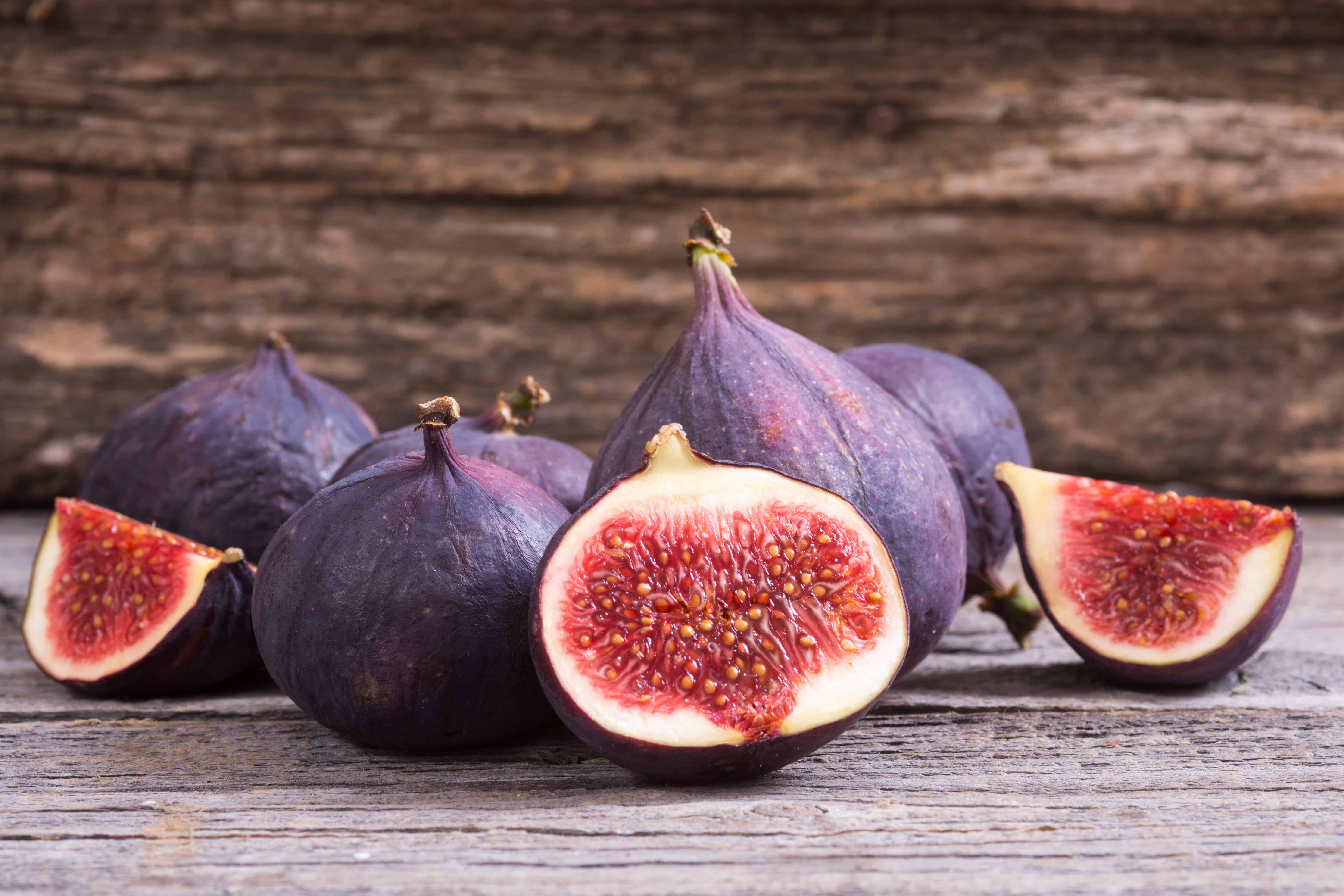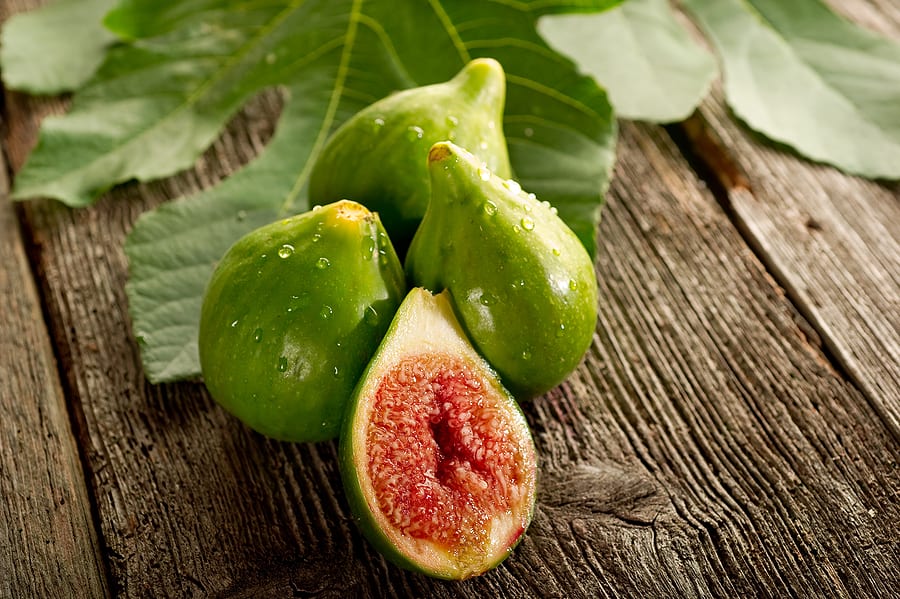Serve figs sliced and drizzled with milk or cream, perhaps add a dusting of sugar.
For a blend of sweet and savory, wrap fig slices in prosciutto, also thinly sliced.

Ripe figs are intensely sweet. Some say the fig is the sweetest of all fruit. That’s probably true. Figs were commonly used as a sweetener before sugar was known.
Ways to serve figs
Figs can be eaten fresh out of hand, dried, or cooked. It’s been that way for thousands of years. Figs are one of the most ancient edible plants. Here are some tasty ways to bring figs to the table:
- Slice or have and add to fruit salads.
- Bake and serve with butter, lemon, and honey.
- Roast with ham or pork: set whole figs in dripping during the last 15 minutes of cooking.
- Wrap halves in slice prosciutto or salami.
- Top open-faced cheese sandwiches with fig slices.
- Serve in a green salad with Roquefort cheese and pecans.
- Spread ginger snaps with cream cheese and top with fig slices.
- Stuff with a small chunk of cherry-flavored Gourmandise cheese.
- Serve slices with custard sauce flavored with orange liqueur.
- Stuff dried figs with almonds or other nuts or sections of an orange.
Fig varieties
There are more than 150 varieties of figs. Figs can be round or oval or pear-shaped and can range in color from purple to black to green to white. Ripe figs have one thing in common they are very delicate and highly perishable.
The Black Mission and Brown Turkey are perhaps the best-known figs. Here is a short guide to the figs you can grow or find at a nearby farm market:
- Black Mission or Mission has purple-black skin with strawberry-pink flesh and rich flavor. This fig is harvested from late spring through late autumn.
- Brown Turkey is pear-shaped, brownish-purple with richly flavored red flesh. Find this fig from late spring through mid-winter.
- Kadota is a small fig with thick, yellow-green skin that is violet-fleshed and has excellent flavor. Available late spring through autumn.
- Calimyrna is a large, squat fig with greenish-yellow skin and pale pink to white-fleshed. This fig has a nutlike flavor and is available from mid to late summer.
- Brunswick also called Magnolia is a large, dark brown fig with a pinkish-yellow flesh and mild flavor.
- Celeste is a medium size, pear-shaped fig with violet-purple skin and tasty rose-colored flesh.
- Smyrna is a dark-skinned fig commonly popular for drying.
- Adriatic is a pear-shaped fig that is violet to brown-skinned.
Fig harvest season
There are two seasons for figs: first early summer and then again from midsummer through late autumn. In some regions, figs can still be harvested in early winter. In the northern hemisphere, fresh figs can be found in some farm markets at Christmas.
How to choose figs
Figs must be picked at their peak. They do not ripen off of the tree. Ripe figs give easily to pressure. Select soft plump figs with firm, intact stems that smell sweet.
Avoid figs that are hard or dry or that have flattened sides or are split or show signs of mold. Select figs that are not bruised. Ripe figs will produce clear, sticky syrup from the blossom end. An overripe fig will have a sour odor due to the fermentation of its juice.
Dried figs should be slightly soft and have a pleasant smell.
How to store figs
Ripe figs are best used immediately after harvest. You can keep figs at room temperature, uncovered, out of the direct sun for a few days. Refrigerate figs for 2 or 3 days in a single layer on a paper towel, covered with plastic wrap. Bring figs to room temperature before serving.
How to prepare figs
Wash figs under cool water before serving. Eat figs whole or peeled. Peel figs with a paring knife. Dried figs can be soaked in water or juice before serving.

Cooking figs
Figs can be baked, grilled, or poached.
- Baking: Rinse figs. Glaze and bake until hot throughout (about 15 minutes).
- Grilling: Rinse figs and cut them into halves. Thread on skewers, making sure the fruit lies flat. Grill until hot (about 4 to 6 minutes).
- Poaching: Rinse 10 to 12 firm-ripe green or black figs. Simmer in poaching liquid until hot and tender (about 3 to 5 minutes.
Fig flavor partners
Figs have a flavor affinity for almonds, anise, blue cheese, chicken, cured meats, duck, lamb, orange, pork, rabbit, and walnuts.
Fig nutrition
Figs are a good source of iron, calcium, phosphorus, and natural sugar. A large fig has about 50 calories.
About figs
Figs grow on trees. A fig tree can grow to 90 feet (27 m) across and nearly as high, but more commonly the fig grows from about 13 to 22 feet (4-7 m) tall. Figleaves have three to five lobes.
Figs are not fruit in the botanical sense, but a fleshy receptacle containing a large number of small brittle, edible seeds, or achenes, which are the actual fruit. You could describe the fig as a fleshy, hollow branch bearing its small flowers and fruit on the inside. There are as many as 1,500 tiny fruits in each fig. Figs are pollinated by tiny wasps that enter the receptacle through a small hole opposite the stem.
Figs are native to the eastern Mediterranean region. They were first cultivated between 4000 and 2700 B.C. The ancient Greeks and Romans were among the first to grow figs for food. The fig was brought to North America by the Spanish Franciscan missionaries in the sixteenth century. Today, figs grow in most temperate regions around the world.
The botanical name for figs is Ficus carica.
Also of interest:
How to Plant, Grow, Prune, and Harvest Figs
Related articles:
Best Herbs for Container Growing
Planning the Home Fruit Garden
Garden Planning Books at Amazon:
- Vegetable Garden Almanac & Planner
- Kitchen Garden Grower’s Guide Vegetable Encyclopedia
- Vegetable Garden Grower’s Guide
- Tomato Grower’s Answer Book
More kitchen tips:
Bring your harvest to the table. Kitchen prep tips and easy recipes for the vegetables you grow. Click below for vegetable prep and recipes you can use now.
- Almonds
- Apples
- Apricot
- Aprium
- Artichoke
- Arugula
- Asparagus
- Avocado
- Bamboo Shoots
- Banana
- Basil
- Beans, Dried
- Beans. Long
- Beans, Shell
- Beans, Snap
- Beets
- Bitter Melon
- Blackberry
- Bok Choy
- Broccoli
- Broccoli Raab
- Brussels Sprouts
- Cabbage
- Cardoon
- Carrots
- Cauliflower
- Celeriac
- Celery
- Chard
- Chayote Squash
- Cherimoya
- Cherries
- Chestnut
- Chickpea
- Chinese Cabbage
- Chives
- Cilantro
- Citron
- Clementine
- Collards
- Coriander
- Corn, Sweet
- Corn, Baby
- Corn Salad, Mache
- Cranberry
- Cress
- Cucumber
- Daikon
- Dandelion
- Dill
- Eggplant
- Endive, Belgian
- Endive and Escarole
- Fava Beans
- Fig
- Florence Fennel
- Garlic
- Ginger
- Grapefruit
- Grapes
- Guava
- Horseradish
- Jerusalem Artichoke
- Jicama
- Jujube
- Kale
- Kiwifruit
- Kohlrabi
- Kumquat
- Leeks
- Lemongrass
- Lemons
- Lettuce
- Lime
- Mache (Corn Salad)
- Mandarin Orange
- Mango
- Maple Syrup
- Marjoram
- Melons
- Michihili
- Mint
- Mizuna
- Mushrooms
- Mushrooms, Cremini
- Mustard Greens
- Napa Cabbage
- Nectarine
- Okra
- Olives
- Olive oil
- Onions
- Oranges
- Oregano
- Parsley
- Parsley Root
- Parsnips
- Passion Fruit
- Pawpaw
- Peaches
- Pears
- Peas, Garden Snap
- Peas, Snow
- Pei Tsai
- Peppers, Chili
- Peppers, Sweet
- Persimmon
- Pineapple
- Pineapple Guava
- Plantain
- Plums
- Pluots
- Pomegranate
- Potatoes
- Prickly Pear
- Pumpkin
- Quince
- Radicchio
- Radishes
- Raspberries
- Rosemary
- Rhubarb
- Rutabaga
- Sage
- Salsify
- Sauerkraut
- Savory
- Shallots
- Sorrel
- Spinach
- Squash, Summer
- Squash, Winter
- Strawberries
- Sunchokes
- Sunflower
- Sweet Potato
- Swiss Chard
- Tangerine
- Taro
- Tarragon
- Thyme
- Tomatillo
- Tomato
- Turnip
- Turnip Greens
- Yams



